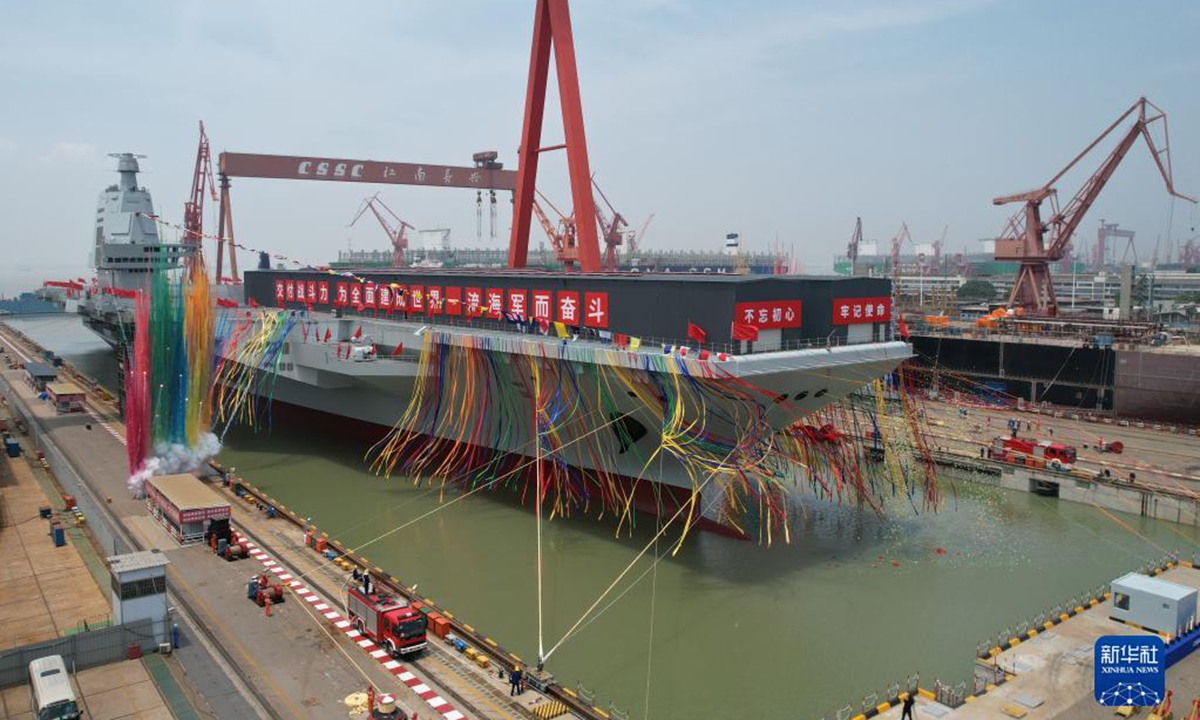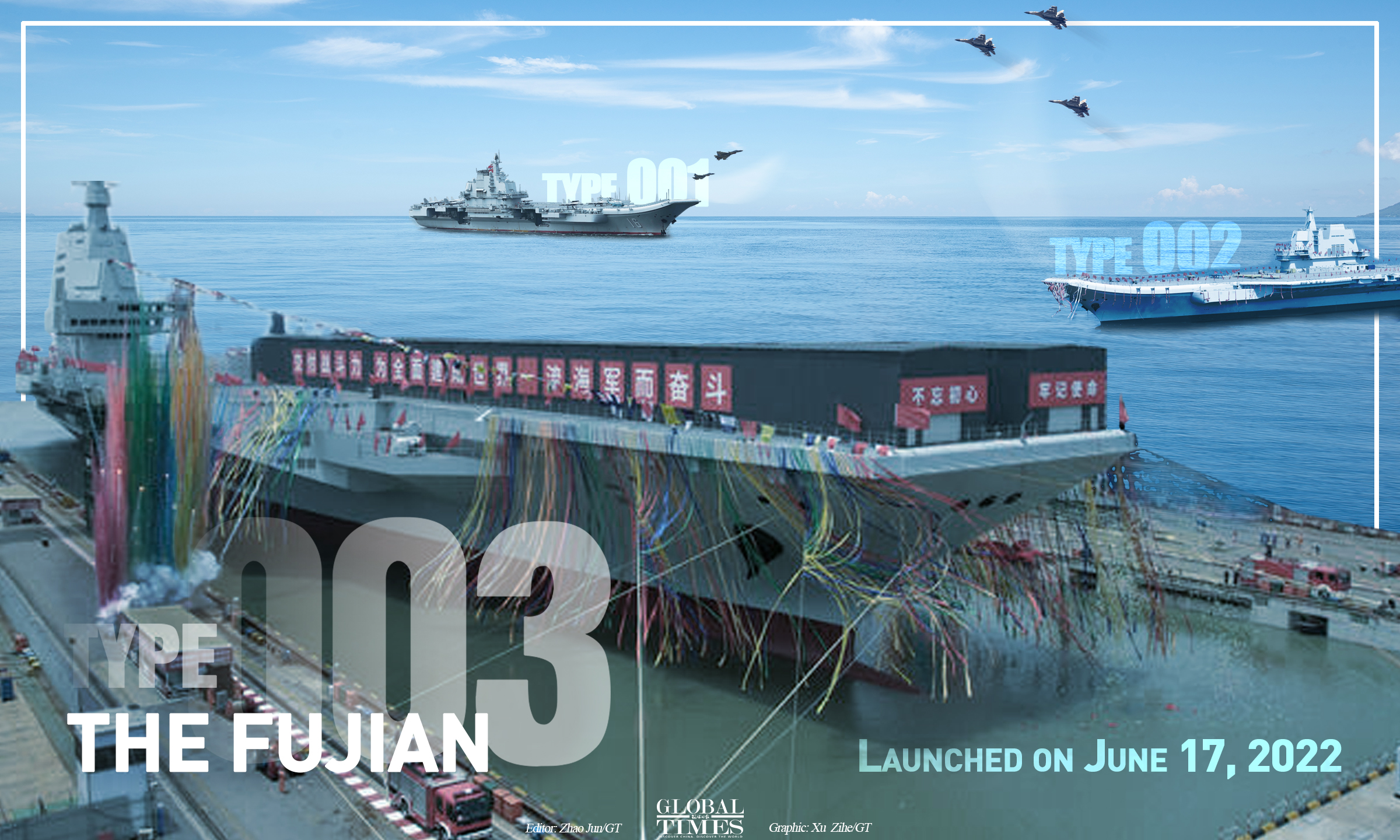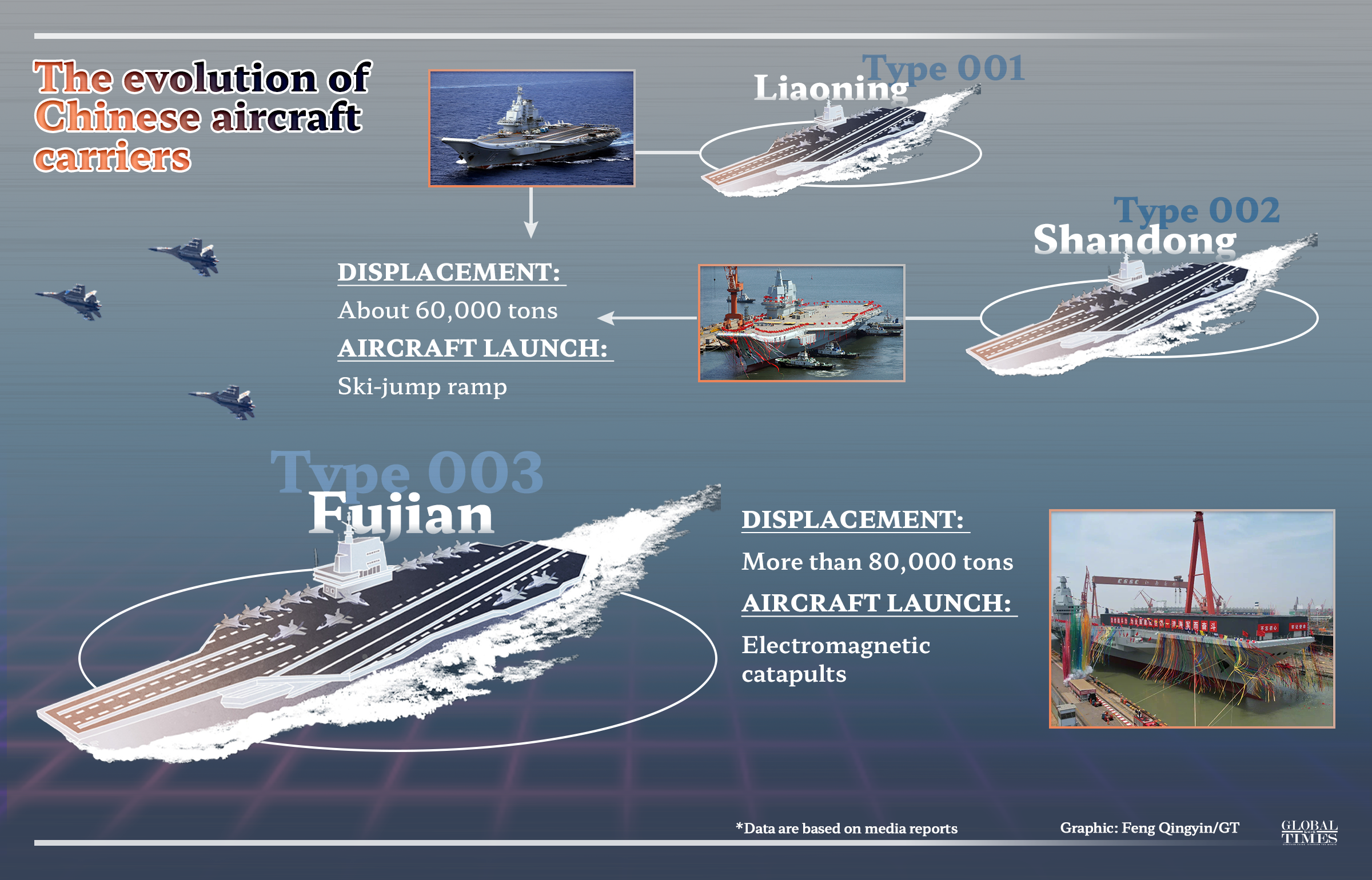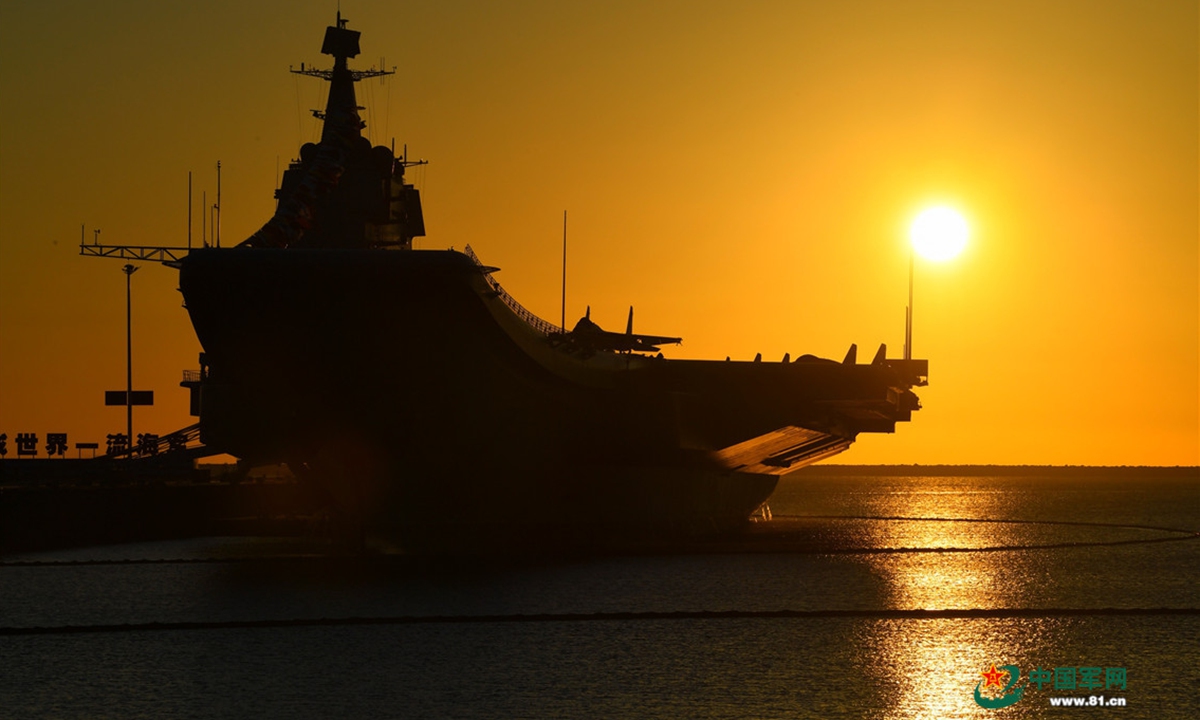
China launches the country's third aircraft carrier in Shanghai on June 17, 2022. Photo: Xinhua
China on Friday launched the country's third aircraft carrier and also its second domestically developed one in Shanghai, a move experts said is a milestone for the vessel's construction and future commissioning.
Having a displacement of more than 80,000 tons, the carrier, named Fujian, is the country's first one equipped with electromagnetic catapults and arresting devices.
As a key landmark in the Chinese People's Liberation Army (PLA) Navy's pursuit to become a blue-water navy, the third carrier is larger, more powerful and more advanced than the previous two, making it the first Chinese aircraft carrier to come close to rival its US counterparts thanks to technologies it uses like catapults, analysts said.
A launch and naming ceremony was held in the Jiangnan Shipyard, a Shanghai-based subsidiary of China State Shipbuilding Corporation Limited, at about 11 am, when the naming certificate of the vessel was given to the top officer to receive the delivery of the aircraft carrier.
Officials then cut the ribbon marking the launch of the third aircraft carrier, after which the vessel left the dock, concluding the ceremony.
Xu Qiliang, a member of the Political Bureau of the Communist Party of China Central Committee and vice-chairman of the Central Military Commission, attended the ceremony.
According to the approval of the Central Military Commission, China's third aircraft carrier is named the Chinese People's Liberation Army Navy Ship
Fujian and given the hull number 18.

Graphic: GT
The
Fujian is China's first fully domestically developed and constructed aircraft carrier with catapults. It has a flat, straight flight deck equipped with electromagnetic catapults and arresting devices, and has a full displacement of more than 80,000 tons.
Fujian is also the name of the eastern coastal province facing the island of Taiwan, leading to speculations from netizens that the carrier could play an important role in safeguarding China's sovereignty, territorial integrity and development interests in the Taiwan question.
After the launch, the carrier will start mooring trials and sea trials.
The launch is a milestone for ship construction, as it indicates that the main structure of the vessel is complete, Song Zhongping, a Chinese military expert and TV commentator, told the Global Times.
After the launch, outfitting work will be finished, fully furbishing the ship with equipment like fuel pipes, gas pipes, electric devices and weapons systems, Song said. Since this is China's first large aircraft carrier equipped with catapults, the outfitting works might take longer than usual to make sure everything is done properly, he said.
A number of sea trials will be carried out after the outfitting work is complete, and the aircraft carrier will hopefully be delivered to the PLA Navy in two to three years from now, Song said.

The evolution of Chinese aircraft carriers Graphic: Feng Qingyin/GT
Capability boostBy comparison, China's current two aircraft carriers, the
Liaoning and the
Shandong, both have a displacement of about 60,000 tons and use ski-jump ramps to assist aircraft launch.
Being larger means the
Fujian can carry more aircraft. Using catapults to replace the ski-jump ramp leads to a significant increase in aircraft sortie rate, allows aircraft to take off carrying more fuel and munitions, and enables heavier aircraft like early warning aircraft and cargo planes to operate on the carrier. Electromagnetic catapults are superior to their steam counterparts because they are lighter, use less resources, recharge faster and can change power output to match the launch needs of different types of aircraft, observers said.
Media reports speculate that the
Fujian could eventually get an improved version of the J-15 heavy fighter jet compatible with catapult launch, an electronic warfare variant of the J-15, a next-generation stealth fighter jet reportedly to be called the J-35, a fixed-wing early warning aircraft dubbed the KJ-600, and armed reconnaissance drones.
The
Fujian will become a key landmark in the PLA Navy's pursuit to become a blue-water navy as well as China's shipbuilding and defense industries, as it is larger, more powerful and more advanced than the PLA Navy's previous two carriers, Song said.
US' most advanced aircraft carrier, the Gerald R. Ford-class, has a displacement of about 100,000 tons, is equipped with four electromagnetic catapults and uses nuclear power.
This means the
Fujian, which is widely believed to use conventional power, is still a level behind the Ford-class, but it has become the first Chinese aircraft carrier to come close to rival its US counterpart, analysts said. Only the US and China have the capability to develop electromagnetic catapult.
The comprehensive combat capability of an aircraft carrier should also be viewed in an aircraft carrier group with escort vessels and in the whole combat system supported by other elements, plus the strategy on how the aircraft carrier should be used. In this case, Chinese escort vessels like the Type 055 large destroyer are very powerful and are superior to their US counterparts, a Beijing-based military expert who requested anonymity told the Global Times.
It is also important to understand that China and the US use aircraft carriers differently. China uses aircraft carriers to safeguard its national sovereignty, security and development interests and protect regional stability and world peace, instead of using them as tools to achieve world hegemony like the US, the expert said.
The strategy of the PLA Navy aims at coastal defense and far sea escort, and this means the third aircraft carrier will excel at combat missions on the doorsteps of China including the Taiwan Straits and the South China Sea even facing possible aggressions by US carriers, and it can also serve its purpose in escort missions far away from China, experts said.
Generally speaking, the
Fujian is China's most advanced aircraft carrier, only second to the US around the world, and its launch will invigorate China's future aircraft carrier program, observers said.

The picture shows aircraft carrier Shandong berths at a naval port in Sanya. China's first domestically-made aircraft carrier Shandong (Hull 17) was officially commissioned to the PLA Navy at a military port in Sanya, South China's Hainan Province, on the afternoon of December 17, 2019, making China one of the few countries in the world that have multiple carriers. Photo: China Military
Putting capabilities aside, the increase in the number of China's aircraft carriers is also of significance.
Based on the general pattern of aircraft carrier operation, a country needs to have a certain number of aircraft carriers to ensure they can be effectively deployed, Li Jie, a Chinese naval expert, told the Global Times.
In order to maintain air superiority and control of the sea in a strategic region, three aircraft carriers are needed, Li said, noting that one will be put on combat alert, one on training missions, and the other will be put under maintenance.
In terms of location, China's second carrier, the
Shandong, is based in Sanya, South China's Hainan Province near the South China Sea, while the
Liaoning, the first carrier, is based in Qingdao, East China's Shandong Province near the East China Sea, Yellow Sea and Bohai Sea. The homeport of the newly launched
Fujian is not yet announced.
Senior Captain Liu Wensheng, spokesperson of the PLA Navy, said on Friday that the Navy will choose the deployment location of the Fujian based on the need to safeguard national sovereignty, security and development interests, as well as the characteristics of carrier operations and logistics support conditions of the port.
According to regulations governing the naming of PLA Navy vessels, aircraft carriers are usually named after provincial administrative units, and that is why the third aircraft carrier is named after East China's Fujian Province, Liu said.







